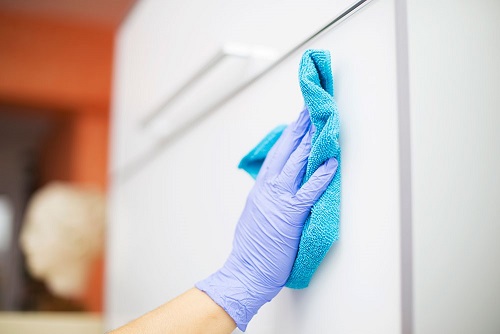 Sanitizing and disinfecting have always been vital for maintaining hygiene, but after COVID-19 they have gained further traction. Think of infectious diseases prevention as a 3-step exercise: cleaning, sanitizing, and disinfecting.
Sanitizing and disinfecting have always been vital for maintaining hygiene, but after COVID-19 they have gained further traction. Think of infectious diseases prevention as a 3-step exercise: cleaning, sanitizing, and disinfecting.
Cleaning is a basic way of removing dirt, allergens, and microorganisms from a surface. You can easily clean a surface using a cloth along with a detergent, soap, or solvent.
Cleaning reduces germs but does not always kill them. Nevertheless, it remains an important step for disease prevention. Getting rid of dust, fingerprints, and other visible marks make sanitizing and disinfecting more effective. Keep reading to find out the difference between sanitizing and disinfecting.
Sanitizing
Sanitizing lowers the number of germs to a safe level. The safe level is determined by public health standards and depends on the requirements of a place. For example, a restaurant that provides food may have a different sanitizing procedure as compared to a workplace.
Sanitizing may not kill all viruses, but reduces them enough to decrease the risk of infection. It is more thorough than cleaning and is necessary for any surface that comes into contact with food.
How you sanitize depends on your specific requirements. For example, you need a mop, a chemical, and some water to mop a floor, whereas you will require a dishwasher to sanitize the dishes. If you want to get a commercial facility sanitized, you will require the help of a commercial cleaning service. Click to explore the services we offer at Service Master Clean.
As per CDC definition, a sanitizer is a chemical that eliminates 99.999% of particular test bacteria in 30 seconds after the conditions of the test. This shows that sanitizing can kill the majority of certain bacteria types, but cannot completely eradicate viruses.
Disinfecting
Disinfecting entails the use of chemicals to eliminate germs. It effectively kills pathogens and microorganisms that spawn diseases.
Virus, grime, and other impurities cannot be completely removed from a surface via disinfectants, but it does kill germs to lower the risk of proliferating infection. Common disinfectants include bleach and alcohol solutions.
To kill viruses on hard surfaces, disinfectants are the only products that are approved by the Environmental Protection Agency (EPA). To fight COVID-19, only disinfectants with emerging pathogen claims should be used. To know about them, check out the EPA N-List.
Difference between sanitizing and disinfecting
The major difference between sanitizing and disinfecting concerns the types of chemicals involved and the period of time it is left on the surface. For best results, leave the disinfectant on a surface for at least 10 minutes. However, make sure you read the instructions on the chemical product for effective disinfection.
Sanitizers are mostly used on surfaces that come in contact with food. A disinfectant can also be used for this purpose, but it must contain safe food chemicals.
Sanitizing is important on surfaces that people commonly come into contact with, such as doorknobs, light switches, and touchpads. It is vital to sanitize bedsheets and undergarments regularly to maintain hygiene.
Disinfecting is necessary if someone in the house is ill or has a weak immune system. To use a disinfectant properly, always follow the instructions on the label.
The difference between sanitizing and disinfecting is that sanitizing reduces germs while disinfecting kills them. Cleaning, sanitizing, and disinfecting are three important steps that you should follow to protect yourself from germs and viruses in your home as well as outdoors. Check out our website if you are looking for a commercial cleaning service for your restaurant, office building, or medical facility.

